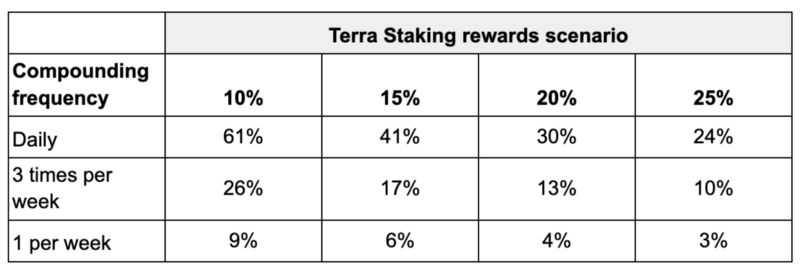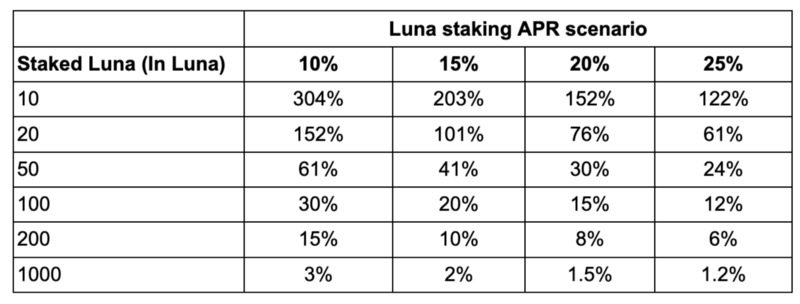Explainer: Stader Staking Rewards Mechanism
The purpose of this article is to clarify the staking rewards on Terra and the benefits of Stader’s unique mechanism.

Explainer: Stader Staking Rewards
The purpose of this article is to clarify the staking rewards on Terra and the benefits of Stader’s unique mechanism.
This article has the following sections:
- Summary
- Staking rewards on Terra
- APRs on Stader dApp
- Stader smart compounding benefits
- Gas fees for manual compounding
- Key questions
- Appendix
1. Summary
(a)
Stader’s key value proposition for Terra users is the following. Most users stake Luna to get Luna rewards vis-a-vis stables. Stader adds value by doing the following.
- Luna rewards auto-compounding
2. Auto-convert stables to Luna and auto-compound it. Currently, stable coin rewards are at 40% of staking rewards. Long term stakers can take advantage of Stader via:
- Additional Luna (bought from stablecoin rewards) auto-compounding
- Gain from long term Luna price appreciation as stables are converted to Luna and restaked.
(b)
Gas fees become prohibitively expensive if a user manually compounds daily or at high frequency. With Stader smart compounding, typical user staking 50–100 Luna is saving significant gas fees while enjoying compounding
1. 3 types of gas fees. Claiming rewards, swapping stables and staking Luna. These gas fees are borne by Stader when you stake with us
2. Gas fees depend on frequency of compounding, # validators staked
- Gas fees per year are ~182 UST, ~77 UST for daily and 3 times/ week manual compounding respectively
2. Staking rewards on Terra
Staking rewards on Terra have 3 major components:
- Luna yield
2. Stablecoin yield
3. Airdrops (ANC, MIR, VKR, MINE currently)
- Refer to Do’s tweet for (2):
- Currently, % of stables as rewards is ~40% due to key changes on Terra.
3. APRs on Stader dApp
- APRs shown on Stader dApp are real values based on staking rewards and airdrops received.
4. Benefits of Smart Compounding
Stader smart compounding benefits users in 4 ways as discussed in several AMAs:
(a)
Compounding Luna staking rewards.
(b)
Claiming and converting stables to Luna and staking.
- 40% staking rewards are in stables. Stader converts stablecoins to Luna and restakes it.
(c)
Gas fees incurred while swapping, re-staking (Stader bears this)
- At least 0.5 UST will be incurred for daily claiming, swapping stables and staking. That’s ~182 UST per year.
- Claiming and re-staking rewards: Min ~0.2 UST
- Swap gas fee for stables to Luna: Min 0.3 UST
2. For an average Luna staker (50–200 Luna), these costs are prohibitively expensive vis-a-vis rewards to do frequent compounding.
(d)
Staking rewards and air drop strategies (To be launched)
- As we implement several yield redirection strategies, users have the opportunity to earn significantly higher returns using them.
5. Gas fees for Manual Compounding
- When you stake with Stader, gas fees are borne by Stader. No additional cost is incurred by delegators.
2. For a 50 Luna staker, gas costs 26% of staking rewards (2.5% APR) to compound even 3 times per week at 10% staking APR.
Gas fees (as % of rewards for 50 Luna staked)

*Each compounding event incurs 0.5 UST gas fees for staking, swapping and restaking leading to ~182 UST per year for daily compounding. Luna = 60 UST. Refer to Appendix 1 for further details
6. Key Questions
What are Stader Plain staking fees?
Stader charges 3% of staking rewards as plain staking fees. We do the following:
- Claiming and compounding Luna staking rewards
- Claiming, swapping stables to Luna and restaking
- Claiming and distributing air drops for users to claim in 1-click
Can I use Stader without paying fees?
- Yes, you can still stake with Stader and choose the retain rewards strategy.
- It is completely free of charge. You can enjoy convenient validator choices, 1-click airdrops and claim rewards within Stader.
- You will have to manually do auto-compounding by claiming, re-staking your rewards.
Why are the fees on LunaX different from Plain staking?
LunaX is a liquid staking token and key utility is the following:
- Ability to unlock immediately on the DEX
- Leveraged staking, take leverage on lending protocols and DEXs to generate higher yields
- Potential for additional yields is very high compared to fees
E.g. Additional returns on leveraging LunaX
- Borrow 60% (LTV) of LunaX value in UST (once lending protocols launch)
- Buy Luna to gain price appreciation
When will additional opportunities on LunaX be available?
- We are actively engaging with several protocols about to launch.
- We will have LunaX integrated with them for LunaX users to enjoy further yield maximization benefits.
7.1. Appendix 1 (Gas fees for daily auto-compounding):
Under manual compounding, gas fees incurred by users during compounding has 3 components:
- Claiming Luna and stables staking rewards: Min 0.15 UST (1 validator)
- Swapping stables to Luna on Terra swap: Min 0.3 UST
- Staking Luna: Min 0.05 UST (1 validator)
*Average fees estimated based on 10 sample transactions. Stader pays for all the gas fees when you stake with Stader as we optimize fees. 1 Luna = 60 UST
For daily compounding,
- Gas fee per day (1+2+3) = 0.5 UST
- Gas fees per year = ~182 UST
Table below shows gas fees as a % of staking rewards for daily compounding.

Gas fees become prohibitively expensive even for users staking 100+ Luna if they want to manually compound daily.
7.2. Appendix 2 (Gas fees for only stables conversion):
- Currently, 40% of staking rewards are paid in stablecoins
- Stakers who want to benefit from long term price appreciation of Luna even for their stable coin rewards, would have to convert their stables to Luna.
- A user has to perform 2 actions and each action incurs gas fees. Total gas fees incurred is at least 0.45 UST per event.
- Claiming rewards (Min 0.15 UST)
2. Swapping stables to Luna (Min 0.3 UST)
Gas fees as a % of staking rewards for a 50 Luna staker are prohibitively expensive to do this frequently.

Assumed 1 Luna = 60 UST.
Stader’s smart compounding avoids all these gas costs generating superior returns vis-a-vis normal staking.